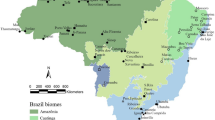Summary
Water is usually considered to be the key limiting factor for growth of desert plants, yet there is little information available of the water-use efficiency of species within a desert community. Leaf carbon isotope ratios, an indicator of long-term intercellular carbon dioxide concentrations and thus of water-use efficiency in C3 plants, were measured on species occurring within a Sonoran Desert community, consisting of wash, transition and slope microhabitats. Along a soil moisture gradient from the relatively wetter wash to the relatively drier slope, leaf carbon isotope ratios increased in all species, indicating that water-use efficiency increased as soil water availability decreased. Leaf carbon isotope ratios of long-lived perennials were substantially more positive than in short-lived perennials, even though plants were growing adjacent to each other. Leaf carbon isotope ratio and leaf duration (evergreen versus deciduous) were not correlated with each other. The results are discussed in terms of how the efficiency of water use may affect community structure and composition.
Similar content being viewed by others
References
Beatley JC (1979) Fluctuations and stability in climax shrub and woodland vegetation of the Mohave, Great Basin and Transition Deserts of southern Nevada. Israel J Bot 28:149–168
Briggs LJ, Shantz HL (1913) The water requirements of plants. II. A review of the literature. USDA Bureau Plant Industry Bull 285
Briggs LJ, Shantz HL (1914) Relative water requirements of plants. J Agric Res 3:1–63
Carpenter DE, Barbour MG, Bahre CJ (1986) Old field succession in Mohave Desert scrub. Madrono 33:111–122
Comstock JP, Cooper TA, Ehleringer JR (1988) Seasonal patterns of canopy development and carbon gain in nineteen warm desert shrub species. Oecologia 75:327–335
Ehleringer JR, Mooney HA (1983) Photosynthesis and productivity of desert and Mediterranean climate plants. In: Ency Plant Physiology New Series, vol 12D. Springer, Berlin Heidelberg New York, pp 205–231
Farquhar GD, O'Leary MH, Berry JA (1982) On the relationship between carbon isotope discrimination and the intercellular carbon dioxide concentration in leaves. Aust J Plant Physiol 9:121–137
Fowler N (1986) The role of competition in plant communities in arid and semiarid regions. Ann Rev Ecol Syst 17:89–110
Goldberg DE, Turner RM (1986) Vegetation change and plant demography in permanent plots in the Sonoran Desert. Ecology 67:695–712
Johnson HB (1975) Gas-exchange strategies in desert plants. In: Gates DM, Schmerl RB (eds) Perspectives in Biophysical Ecology. Springer, Berlin Heidelberg New York, pp 105–120
Klikoff LG (1967) Moisture stress in a vegetational continuum in the Sonoran Desert. Am Midl Nat 77:128–137
MacMahon JA, Schimpf DJ (1981) Water as, a factor in the biology of North American desert plants. In: Evans DD, Thames JL (eds) Water in Desert Ecosystems. Dowden, Hutchinson and Ross, Stroudsburg Pennsylvania, pp 114–171
Mooney HA, Gulmon SL (1982) Constraints on leaf structure and function in reference to herbivory. BioScience 32:198–206
Orians GH, Solbrig OT (1977) A cost-income model of leaves and roots with special reference to arid and semiarid areas. Am Nat 111:677–690
Phillips DL, MacMahon JA (1978) Gradient analysis of a Sonoran Desert bajada. Southwest Nat 23:669–680
Shreve F (1915) The vegetation of a desert mountain range as conditioned by climatic factors. Carnegie Inst Wash Publ 217
Shreve F (1942) The desert vegetation of North America. Bot Rev 8:195–246
Shreve F, Hinckley AL (1937) Thirty years of change in desert vegetation. Ecology 18:463–478
Shreve F, Wiggins IL (1964) Vegetation and Flora of the Sonoran Desert. Stanford University Press, Stanford
Smith SD, Nobel PS (1986) Deserts. In: Baker NR, Long SP (eds) Photosynthesis in Contrasting Environments. Elsevier Science Publ, Amsterdam, pp 13–62
Solbrig OT, Orians GH (1977) The adaptive characteristics of desert plants. Am Sci 65:412–421
Vasek FC (1979) Early successional stages in Mohave Desert shrub vegetation. Israel J Bot 28:133–148
Vasek FC, Johnson HB, Brum GD (1975a) Effects of power transmission lines on vegetation of the Mohave Desert. Madrono 23:114–130
Vasek FC, Johnson HB, Eslinger DH (1975b) Effects of pipeline construction on creosote bush scrub vegetation of the Mohave Desert. Madrono 23:1–13
Webb RH, Steiger JW, Turner RM (1987) Dynamics of Mohave Desert shrub assemblages in the Panamint Mountains, California. Ecology 68:478–490
Wells PV (1961) Succession in desert vegetation on streets of a Nevada ghost town. Science 134:670–671
Yang TW, Lowe CH (1956) Correlation of major vegetation climaxes with soil characteristics in the Sonoran Desert. Science 123:542
Author information
Authors and Affiliations
Rights and permissions
About this article
Cite this article
Ehleringer, J.R., Cooper, T.A. Correlations between carbon isotope ratio and microhabitat in desert plants. Oecologia 76, 562–566 (1988). https://doi.org/10.1007/BF00397870
Received:
Issue Date:
DOI: https://doi.org/10.1007/BF00397870




